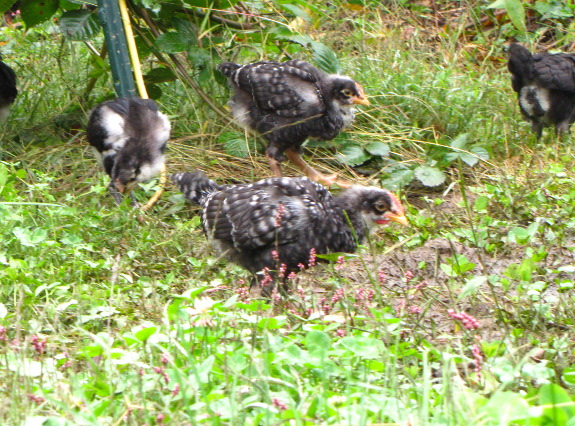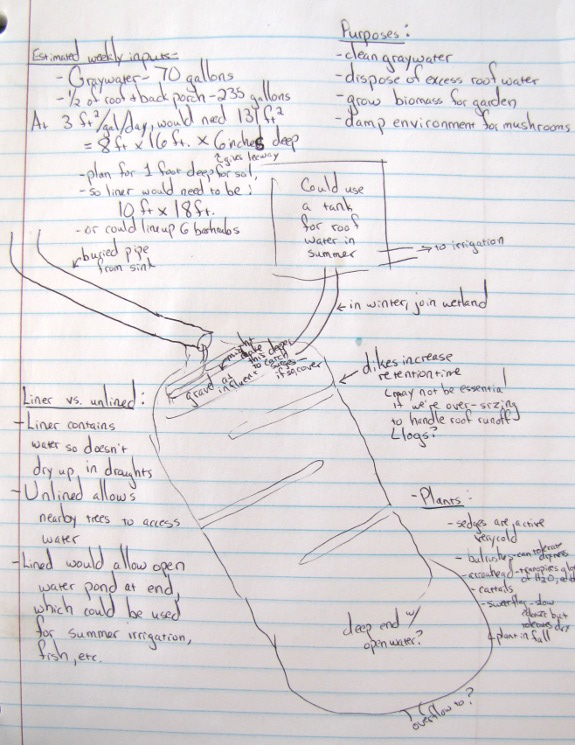
How to seal a pond or constructed wetland

Our greywater
swamp
became a much more pressing problem last week as the grasses and
clovers began to go dormant. In the summer, actively growing
vegetation pushes an astonishing amount of water from the soil up into
the
air via transpiration, but once the weather cools and plants slow down,
the ground is on a trend toward increasing wetness. While our
chicks love hunting for bugs in the greywater effluent, we stopped
going out the back door because it was just too swampy. I guess
it's time to put greywater management on the list!
After some
brainstorming, Mark and I agreed that a constructed
wetland
was the way to go. But what would it look like? I thought
you might enjoy seeing what goes through my head when I'm
thinking about a design like this:

In case you can't read
my scrawl, the big questions pertained to
lining. Should we line the wetland at all, and if so with what?
As we know from
experience, our clay soil will create a boggy spot
where the greywater comes out even without a liner. Assuming
you're not cleaning up something really toxic (in which case, a liner
is recommended to keep the toxins from leaching into the groundwater),
the only real reason to line a constructed wetland is to keep the soil
from
drying up during the summer. However, a liner does have benefits
--- it allows real wetland plants to take hold over a large area, and
can even be used to create a pool of clean water at the end of the
wetland for irrigation or frog habitat.
If we do decide to line
the wetland, there are three options:
- Purchase a pond liner. If we went for the high quality version, that would be pricey --- $266.
- Compact clay soil. Mainstream folks tend to rent mechanized compacters to mash wet clay around under pressure and create a nearly impenetrable liner.
- Gley the pond. You
can read my post about gleying
here. (Using pigs to seal a pond is a method of gleying.)
Of course you know which
option appeals to me, but our little wetland
is nowhere near big enough to make it worthwhile to raise pigs just to
seal it, and the area is at the same time too big to haul in enough
manure to gley without animals. I'm wondering how much stomping
around in boots would be required to compact the soil, and whether
chickens can be used to gley ponds. Ideas?
Want more in-depth information? Browse through our books.
Or explore more posts by date or by subject.
About us: Anna Hess and Mark Hamilton spent over a decade living self-sufficiently in the mountains of Virginia before moving north to start over from scratch in the foothills of Ohio. They've experimented with permaculture, no-till gardening, trailersteading, home-based microbusinesses and much more, writing about their adventures in both blogs and books.
Want to be notified when new comments are posted on this page? Click on the RSS button after you add a comment to subscribe to the comment feed, or simply check the box beside "email replies to me" while writing your comment.

Anna, have you seen the EPA going after folks for doing stuff like this over the last 4 years? It's scary. The EPA has even claimed they have the power to classify a property a "wet lands" if it has puddles after a rain. The most prominent story on this abuse of power is out of Idaho where a couple bought a piece of ground with the intention of building a house on it. The EPA had them tied up for years. The EPA even went to far as to say the couple had NO LEGAL RIGHT to challenge the EPA ruling! It took a Supreme Court case to allow the challenge to be made. Our government is out of control!
http://www.washingtonpost.com/politics/supreme-court-allows-idaho-couple-to-challenge-epa-on-wetlands-ruling/2012/03/21/gIQAFgdsRS_story.html
I don't think you really would need to seal it, based on what I read on your blog every year- rain, rain, and rain in your clay soil...
One thing I found from our first greywater system and my rice paddy is that they seal themselves pretty well given enough time. All the bits of food rinsed off plates, any oils or grease, and soaps contribute to an organic slime that will slowly grow out away from the pipe (and clog your infiltration medium). Rainwater will add some fines to the system. Basically all raindrops were once a mote of dust- it adds up over time. Also, the greywater plants will die and contribute to the mix.
In Japan, the rice farmers till their flooded paddies with rototillers. It compacts the base, and stirs up the top 10cm or so to settle out naturally, thus leaving a thick layer of clay on the top. And every year the irrigation water to flood the paddy deposits just a touch of new mud washed out of the mountains. I get growth of about 1mm/year in clay and silt from the input water to my paddy. I think two people stomping around in boots after a good rain would make a pretty tight seal.
If you have a problem with it percolating too fast, you could just bury a few buckets to their rims. They wouldn't drain dry like the rest of the basin, and you could contain the planting of vigorous spreaders in one area (cattails for example)
Irma --- I'm afraid the space is too small to even make it worthwhile to set up the infrastructure (fencing, etc.) for a rental pig.
Heath --- There's a big difference between a man-made area where water ends up puddling and a real wetland. I'm actually very much in favor of protecting the latter (even if it only looks like a puddle to the untrained eye), and of turning our man-made area into as much like a natural wetland as possible. But I'm a treehugger.
Eric --- Awesome data! I really appreciate you doing the experimentation so we can just follow your lead. You've pretty much sold me on your method --- just digging out a spot for the water to pond, and maybe adding some buckets of cattails to get things started. Thanks!
Anonymous --- That seems to support Eric's data --- that just adding the water can naturally gley the wetland. I hope it works!
I've been pondering using bathtubs to construct a greywater system.
The only practical place for us to run our greywater is down the border of our property (the house is close to the fenceline), and it's not wide enough to do something in-ground. I also don't want to risk it overflowing or leaching into our neighbour's paddock. But a series of bathtubs would fit nicely.
I recall John Wells on the Field Lab blog hauling in Benonite (sp?) to seal a dam he built on a creek... Not sure what all that involves or if it is even practical.
My OTHER job is installing/repairing septic systems... Occasionally we dig lagoons and have never worried about sealing them, like Eric says they will naturally with the constant saturation. I brought one up to code recently that had been let go and had completely dried up during the summer drought... When we were digging it out it went from dust on the surface to so much mud underneath our machines were getting stuck. After a couple more feet we hit moderately dry soil again!
Darren --- I got bogged down on bathtubs when I realized that my capacity estimates were way off on my drawing above. I was figuring on just filling the bathtubs with water, but of course they'd already be full of gravel, sand, and/or dirt to grow plants, so I'd actually need a lot more of them.
But in a place like Australia where water is presumably scarce, it might be worthwhile. Also, I'm pouring all of my roof water in as well, which you probably wouldn't be doing. I'll look forward to seeing what you do on your blog!
Phil --- Bentonite is a kind of powdered clay that folks often send into cracks in dams to try to get it to reseal. I don't hear much about people using it to seal a whole pond in the first place, but they might.
Interesting story about your lagoons! What part of the country do you live in?